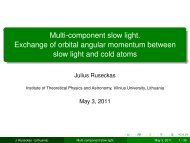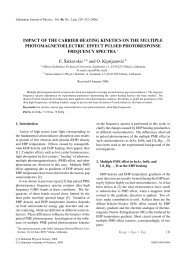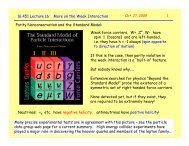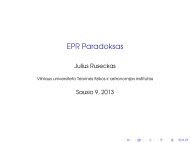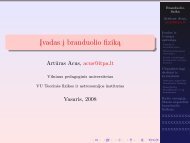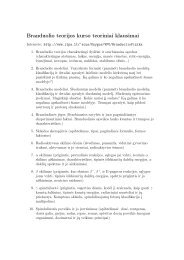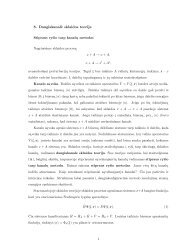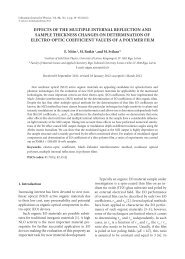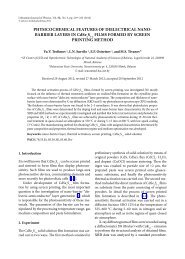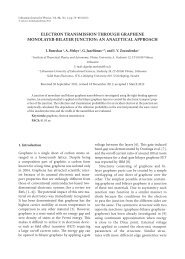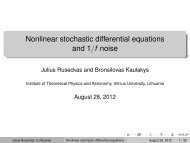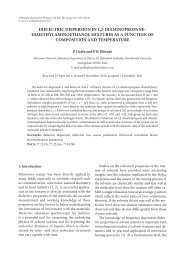The electron affinity of 2s2p2 4P in boron
The electron affinity of 2s2p2 4P in boron
The electron affinity of 2s2p2 4P in boron
Create successful ePaper yourself
Turn your PDF publications into a flip-book with our unique Google optimized e-Paper software.
J. Phys. B: At. Mol. Opt. Phys. 29 (1996) 1169–1173. Pr<strong>in</strong>ted <strong>in</strong> the UK<br />
<strong>The</strong> <strong>electron</strong> <strong>aff<strong>in</strong>ity</strong> <strong>of</strong> 2s2p 2 4 P <strong>in</strong> <strong>boron</strong><br />
Charlotte Froese Fischer† and Gedim<strong>in</strong>as Gaigalas‡<br />
† Vanderbilt University, Box 1679B, Nashville, TN 37235, USA<br />
‡ Institute <strong>of</strong> <strong>The</strong>oretical Physics and Astronomy, Lithuanian Academy <strong>of</strong> Sciences, A Goštauto<br />
12, Vilnius 232600, Lithuania<br />
Received 29 September 1995<br />
Abstract. Systematic MCHF procedures are applied to the study <strong>of</strong> the <strong>electron</strong> <strong>aff<strong>in</strong>ity</strong> <strong>of</strong> <strong>boron</strong><br />
relative to the 2s2p 2 4 P state. Several models are used. An <strong>electron</strong> <strong>aff<strong>in</strong>ity</strong> <strong>of</strong> 1.072(2) eV is<br />
predicted.<br />
1. Introduction<br />
<strong>The</strong> ab <strong>in</strong>itio calculation <strong>of</strong> <strong>electron</strong> aff<strong>in</strong>ities (EAs) for even small systems has been a<br />
challenge for many atomic and molecular codes. Quantum chemical calculations strive for<br />
‘chemical accuracy’ <strong>of</strong> 1 kcal mol −1 (40 meV). In experimental atomic physics the measured<br />
accuracy varies by orders <strong>of</strong> magnitude for different systems [1] but accuracies to a few<br />
meV are common. New resonant ionization, spectroscopic methods for negative ions can<br />
yield EAs to an accuracy <strong>of</strong> 0.1–0.2 meV [2]. A recent measurement for the <strong>electron</strong> <strong>aff<strong>in</strong>ity</strong><br />
<strong>of</strong> Al [3] has reduced the uncerta<strong>in</strong>ty <strong>of</strong> an earlier measurement from 10 meV to only 0.3<br />
meV. Thus considerable progress has been made <strong>in</strong> experimental techniques. With present<br />
day high-performance computers, similar improvements <strong>in</strong> accuracy should be possible for<br />
ab <strong>in</strong>itio results.<br />
Many calculations for <strong>electron</strong> aff<strong>in</strong>ities have been performed for the first row elements,<br />
<strong>in</strong>clud<strong>in</strong>g <strong>boron</strong>. For a review <strong>of</strong> early calculations for a range <strong>of</strong> systems, see Bunge and<br />
Bunge [4]. More recently, most calculations have relied on quantum chemical basis set<br />
methods [5] where basis-set truncation errors are present as well as errors aris<strong>in</strong>g from an<br />
unbalanced treatment <strong>of</strong> correlation <strong>in</strong> the atom and anion. Some very accurate valence<br />
correlation results have been reported by Noro et al [6] us<strong>in</strong>g an extensive basis <strong>in</strong> a<br />
multi-reference configuration <strong>in</strong>teraction (MRCI) calculation. Only s<strong>in</strong>gle and double (SD)<br />
replacements are <strong>in</strong>cluded and the method relies on corrections that estimate the effect <strong>of</strong><br />
the omitted triple and quadruple excitations. Uncerta<strong>in</strong>ty estimates are not usually provided.<br />
Recently, an MCHF <strong>electron</strong> <strong>aff<strong>in</strong>ity</strong> <strong>of</strong> 279.5(20) meV was reported for the <strong>electron</strong><br />
<strong>aff<strong>in</strong>ity</strong> <strong>of</strong> the <strong>boron</strong> ground state [7] to be compared with a measured value <strong>of</strong><br />
277(10) meV [1]. Most difficult to estimate is the uncerta<strong>in</strong>ty <strong>in</strong> the computed result.<br />
Only more accurate experimental data will determ<strong>in</strong>e the validity <strong>of</strong> the assumptions about<br />
uncerta<strong>in</strong>ty. Another <strong>in</strong>terest<strong>in</strong>g case is the <strong>electron</strong> <strong>aff<strong>in</strong>ity</strong> <strong>of</strong> the excited 2s2p 2 4 P state.<br />
With the b<strong>in</strong>d<strong>in</strong>g <strong>of</strong> an extra 2p <strong>electron</strong> to form the negative ion, the lowest state is 2s2p 35 S<br />
for which the selection rules greatly reduce the size <strong>of</strong> the expansions needed <strong>in</strong> an MCHF<br />
calculation. This case was <strong>in</strong>vestigated by Bunge and Bunge [4] almost two decades ago<br />
who reported an EA <strong>of</strong> 0.89(2) eV. In this paper we revisit this problem and report results<br />
0953-4075/96/061169+05$19.50 c○ 1996 IOP Publish<strong>in</strong>g Ltd 1169
1170 C Froese Fischer and G Gaigalas<br />
from systematic MCHF calculations. Several different computational models are used which<br />
are important <strong>in</strong> assess<strong>in</strong>g the uncerta<strong>in</strong>ty.<br />
2. MCHF calculations for the <strong>electron</strong> <strong>aff<strong>in</strong>ity</strong><br />
In an MCHF calculation [8], the wavefunction is expressed as a l<strong>in</strong>ear comb<strong>in</strong>ation <strong>of</strong><br />
configuration state functions (CSFs) which are antisymmetrized products <strong>of</strong> one-<strong>electron</strong><br />
sp<strong>in</strong>-orbitals. A set <strong>of</strong> orbitals, or active set (AS), determ<strong>in</strong>es the set <strong>of</strong> all possible CSFs or<br />
the complete active space (CAS) for an MCHF calculation. <strong>The</strong> latter grows rapidly with the<br />
number <strong>of</strong> <strong>electron</strong>s and also the size <strong>of</strong> the active set. Thus most MCHF expansions are<br />
limited to a restricted active space (RAS). Several different notations have been proposed<br />
for def<strong>in</strong><strong>in</strong>g the RAS. Some are expressed <strong>in</strong> terms <strong>of</strong> s<strong>in</strong>gle (S), double (D), triple (T)<br />
and quadruple (Q) excitations from one or more reference CSFs [9]. In systematic MCHF<br />
calculations it has been found convenient to def<strong>in</strong>e the RAS <strong>in</strong> terms <strong>of</strong> pr<strong>in</strong>cipal quantum<br />
numbers which, for virtual orbitals, merely def<strong>in</strong>e the order <strong>in</strong> which they are <strong>in</strong>troduced<br />
<strong>in</strong>to the basis. CSFs may be expressed <strong>in</strong> a canonical form by associat<strong>in</strong>g with each CSF an<br />
<strong>in</strong>teger (or sequence) constructed from the one-<strong>electron</strong> pr<strong>in</strong>cipal quantum numbers assumed<br />
to be <strong>in</strong> <strong>in</strong>creas<strong>in</strong>g left to right order. <strong>The</strong>re may, <strong>of</strong> course, be many different sp<strong>in</strong>-angular<br />
coupl<strong>in</strong>gs associated with a given <strong>in</strong>teger. <strong>The</strong> latter may then be used to def<strong>in</strong>e an order<br />
for the CSFs and by specify<strong>in</strong>g the highest <strong>in</strong>teger provides a simple notation for def<strong>in</strong><strong>in</strong>g the<br />
RAS, at least for few-<strong>electron</strong> systems. For example, (1 134)def<strong>in</strong>es a RAS where the 1s 2<br />
core is <strong>in</strong>active, the maximum pr<strong>in</strong>cipal quantum number is 4 but at least one outer <strong>electron</strong><br />
must have n 3. One feature <strong>of</strong> large-scale computation is that, as the AS is <strong>in</strong>creased, the<br />
important CSFs conta<strong>in</strong><strong>in</strong>g high-n orbitals approach the CSFs obta<strong>in</strong>ed from SD excitations<br />
<strong>of</strong> a multi-reference (MR) set. <strong>The</strong> members <strong>of</strong> this set cannot always be identified <strong>in</strong><br />
advance and adaptive techniques may be used [11]. In previous publications [7, 10] we<br />
have described computational models <strong>in</strong> terms <strong>of</strong> ‘layers’ specify<strong>in</strong>g the range <strong>of</strong> pr<strong>in</strong>cipal<br />
quantum numbers for each group <strong>of</strong> <strong>electron</strong>s. In this paper, we specify <strong>in</strong>stead, the range <strong>of</strong><br />
pr<strong>in</strong>cipal quantum numbers for each <strong>electron</strong>. S<strong>in</strong>ce the lowest pr<strong>in</strong>cipal quantum numbers<br />
are determ<strong>in</strong>ed by symmetry, parity, and the exclusion pr<strong>in</strong>ciple, only the highest need to<br />
be specified. From the set <strong>of</strong> pr<strong>in</strong>cipal quantum numbers, all possible CSFs are generated<br />
with the orbital angular quantum number restricted to l 6(iorbitals). Another restriction<br />
<strong>in</strong> our codes is that orbitals with l 3 can be at most doubly occupied, a restriction not<br />
expected to be significant <strong>in</strong> the present study.<br />
<strong>The</strong> <strong>electron</strong> <strong>aff<strong>in</strong>ity</strong> <strong>of</strong> an atom is an outer-<strong>electron</strong> property. In the valence correlation<br />
model, which we describe first, the 1s 2 core is considered to be <strong>in</strong>active and the atom and<br />
negative ion (or anion) can be treated as three- and four-<strong>electron</strong> systems, respectively. Up<br />
to the active set conta<strong>in</strong><strong>in</strong>g all orbitals with pr<strong>in</strong>cipal quantum numbers 7 (called the<br />
n = 7 AS) all possible CSFs were <strong>in</strong>cluded. However, deletion <strong>of</strong> CSFs with coefficients less<br />
than 10 −6 did not affect the total energy to the digits reported. In the case <strong>of</strong> 5 S, the last CSF<br />
had pr<strong>in</strong>cipal quantum numbers (1 15677). This observation was used to restrict the new<br />
CSFs for the n = 8 calculation. In the case <strong>of</strong> the 4 P, orbitals with n = 8 were constra<strong>in</strong>ed<br />
to be doubly occupied. <strong>The</strong> range <strong>of</strong> pr<strong>in</strong>cipal quantum numbers for this calculation is<br />
summarized <strong>in</strong> table 1. Notice that, because two schemes were used for the anion the RAS<br />
for 5 S consists <strong>of</strong> a union <strong>of</strong> two sequences.<br />
<strong>The</strong> calculation for a specific n consists <strong>of</strong> the subset <strong>of</strong> the RAS def<strong>in</strong>ed <strong>in</strong> table 1.<br />
Table 2 reports the size <strong>of</strong> the RAS, the <strong>in</strong>dividually optimized energy, and the <strong>electron</strong><br />
<strong>aff<strong>in</strong>ity</strong>. <strong>The</strong> latter may be def<strong>in</strong>ed as E n ( 4 P) − E n ( 5 S) (the n = 0 <strong>electron</strong> <strong>aff<strong>in</strong>ity</strong>)<br />
but another def<strong>in</strong>ition, motivated by the fact that more orbitals are needed to represent the
Electron <strong>aff<strong>in</strong>ity</strong> <strong>of</strong> 2s2p 2 4 P <strong>in</strong> <strong>boron</strong> 1171<br />
Table 1. <strong>The</strong> range <strong>of</strong> pr<strong>in</strong>cipal quantum numbers def<strong>in</strong><strong>in</strong>g the restricted active space for two<br />
different computational models.<br />
B( 4 P) B − ( 5 S)<br />
Valence correlation<br />
11788 117777∪115688<br />
With core polarization<br />
11555 115555<br />
∪ 12388 ∪123455∪123388<br />
Table 2. Systematic MCHF energies for restricted active space calculations with an <strong>in</strong>creas<strong>in</strong>g<br />
active set <strong>of</strong> orbitals. For each calculation, n specifies the maximum quantum number; angular<br />
quantum numbers were restricted to l 6; orbitals were separately optimized for both states.<br />
B 4 P B − 5 S EA (eV)<br />
Expansion CSF E n CSF E n n = 0 n = 1<br />
Valence correlation only<br />
n = 3 11 −24.467 169 2 14 −24.502 744 6 0.968 06<br />
n = 4 64 −24.469 344 6 141 −24.507 948 0 1.050 45<br />
n = 5 240 −24.469 714 1 866 −24.508 882 5 1.065 83 1.075 88<br />
n = 6 699 −24.469 803 0 3 921 −24.509 101 8 1.069 38 1.071 79<br />
n = 7 1 755 −24.469 831 9 14 131 −24.509 167 7 1.070 38 1.071 17<br />
n = 8 3 475 −24.469 839 5 18 057 −24.509 186 4 1.070 68 1.070 89<br />
Estimated non-relativistic limit 1.0708(1)<br />
Estimated limit with relativistic correction 1.0700(1)<br />
Valence correlation + core polarization<br />
n = 4 1 381 −24.487 859 9 2 667 −24.524 801 8 1.005 24<br />
n = 5 2 119 −24.490 686 3 8 603 −24.529 351 4 1.052 13<br />
n = 6 4 622 −24.491 259 5 13 701 −24.530 456 7 1.066 105 1.082 21<br />
n = 7 8 486 −24.491 473 0 21 753 −24.530 818 0 1.070 632 1.076 44<br />
n = 8 11 611 −24.491 560 9 23 203 −24.530 962 9 1.072 17 1.074 58<br />
Estimated non-relativistic limit 1.0733(3)<br />
Estimated limit with relativistic correction 1.0724(4)<br />
negative ion, could be E n−1 ( 4 P)−E n ( 5 S) (the n = 1 <strong>electron</strong> <strong>aff<strong>in</strong>ity</strong>). Table 1 shows that<br />
the former is <strong>in</strong>creas<strong>in</strong>g with n whereas the latter is decreas<strong>in</strong>g. Both can be extrapolated<br />
approximately; however, <strong>in</strong> this case the results are so well converged that one can also<br />
use the average <strong>of</strong> the last two values with the uncerta<strong>in</strong>ty be<strong>in</strong>g the difference between the<br />
average and the computed values. <strong>The</strong>se are modified by a relativistic shift which from an<br />
n = 6 calculation was found to be −0.000 78 eV.<br />
But the outer correlation model will have some error associated with it aris<strong>in</strong>g from the<br />
neglect <strong>of</strong> correlation with the 1s 2 core which represents the polarization <strong>of</strong> the core by the<br />
outer <strong>electron</strong>s. Table 1 lists the range <strong>of</strong> pr<strong>in</strong>cipal quantum numbers for this model which<br />
<strong>in</strong>cludes a s<strong>in</strong>gle excitation from the core. All calculations start by <strong>in</strong>clud<strong>in</strong>g all the CAS<br />
from an n = 5 valence correlation calculation, but when the 1s 2 core is opened, the second<br />
<strong>electron</strong> must have a pr<strong>in</strong>cipal quantum number no greater than 2; the third, no greater than<br />
3 at which po<strong>in</strong>t the RAS beg<strong>in</strong> to differ for the two cases. In all calculations, high-n orbitals<br />
need to be doubly occupied. S<strong>in</strong>ce 4 P has fewer <strong>electron</strong>s, there are also fewer <strong>in</strong> the ‘core’.<br />
At the n = 5 level, the four-<strong>electron</strong> ‘core’ is (1 234)whereas for n 6 it has been<br />
restricted further to (1 2 3 3). Notice also that this valence + core-polarization calculation<br />
has restricted valence correlation appreciably more than the first model calculation. <strong>The</strong>
1172 C Froese Fischer and G Gaigalas<br />
n = 0 and n = 1 <strong>electron</strong> aff<strong>in</strong>ities can each be extrapolated approximately. A fairly<br />
reliable technique is to use the ratio (r) <strong>of</strong> the last two changes. <strong>The</strong>n, if is the last<br />
change, assum<strong>in</strong>g the rema<strong>in</strong><strong>in</strong>g corrections form a geometric series, the rema<strong>in</strong>der can be<br />
shown to be r/(1 − r). In this case the average <strong>of</strong> the two <strong>electron</strong> aff<strong>in</strong>ities is slowly<br />
decreas<strong>in</strong>g and this may also be used <strong>in</strong> determ<strong>in</strong><strong>in</strong>g the limit and its uncerta<strong>in</strong>ty. <strong>The</strong>se<br />
extrapolated values too need to be corrected for a relativistic shift <strong>of</strong> −0.000 935 eV.<br />
F<strong>in</strong>ally, a calculation was performed that treats both systems as a whole. Now the<br />
configuration space needs to be constricted even more and a MR-SD pair-correlation scheme<br />
was employed similar to the one used by Noro et al [6] for outer correlation. Basically,<br />
SD replacements are applied to the most important components <strong>of</strong> the wavefunction and<br />
coupled as pair-correlation functions <strong>of</strong> the reference CSF. <strong>The</strong>se are listed <strong>in</strong> table 3 for<br />
the two states. Table 4 reports the number <strong>of</strong> CSFs and the energies from <strong>in</strong>creas<strong>in</strong>g active<br />
sets. <strong>The</strong> latter <strong>in</strong>crease rapidly with the size <strong>of</strong> the active set.<br />
Table 3. <strong>The</strong> multi-reference configuration states for a full correlation MR-SD study that <strong>in</strong>cludes<br />
core–core correction.<br />
4 P 2s2p 2 , 2s3p 2 , 2s3d 2 , 2p 2 3d, 2p3s3p<br />
5 S 2s2p 3 , 2s2p3p 2 , 2s2p3d 2 , 2p 2 3s3p, 2p 2 3p3d<br />
Table 4. Systematic MCHF results for multi-reference SD pair-correlation excitations.<br />
B<strong>4P</strong> B − 5S EA (eV)<br />
Expansion CSF E n CSF E n n = 0 n = 1<br />
n = 4 681 −24.510 810 4 757 −24.546 749 4<br />
n = 5 1 590 −24.517 483 1 1 953 −24.554 478 4<br />
n = 6 2 987 −24.5197691 3 876 −24.558 030 2<br />
n = 7 4 971 −24.520 8036 6 674 −24.559 651 8<br />
n = 8 7 549 −24.521 280 8 10 356 −24.560 343 6 1.062 95 1.075 90<br />
n = 9 10 721 −24.521 504 7 14 922 −24.560 664 2 1.065 58 1.071 68<br />
n = 10 14 487 −24.521 618 6 20 372 −24.560 826 8 1.066 93 1.070 03<br />
Extrapolated MR-CI limit 1.068 48<br />
With Davidson correction 1.072 94<br />
Estimated limit with relativistic correction 1.071 76<br />
For large n, the weight <strong>of</strong> the reference set converges to 0.9974 and 0.9948, respectively,<br />
for 4 P and 5 S. This small difference <strong>of</strong> 0.26% requires a small correction. In arriv<strong>in</strong>g at<br />
accurate <strong>electron</strong> aff<strong>in</strong>ities for <strong>boron</strong> us<strong>in</strong>g the MR-SD scheme, Noro et al applied a Davidson<br />
correction [13] to estimate omitted correlation. Though a number <strong>of</strong> different schemes have<br />
been proposed (see [14] for a discussion), we use the same correction used by Noro et al,<br />
namely<br />
[<br />
E = 1 − ∑ ]<br />
ci<br />
2 (E ref − E MCHF )<br />
i<br />
where the sum is over the reference configuration states, and E ref is the energy <strong>of</strong> the<br />
<strong>in</strong>teraction matrix restricted to the reference configuations.<br />
Table 4 also reports the corrected energies. <strong>The</strong> <strong>electron</strong> <strong>aff<strong>in</strong>ity</strong> is <strong>in</strong>creased by<br />
0.004 46 eV by this correction and, as <strong>in</strong> earlier models, decreased when relativistic<br />
corrections are <strong>in</strong>cluded. In the full-correlation model the relativistic shift <strong>in</strong>creased <strong>in</strong>
Electron <strong>aff<strong>in</strong>ity</strong> <strong>of</strong> 2s2p 2 4 P <strong>in</strong> <strong>boron</strong> 1173<br />
magnitude to −0.001 1821 eV. Table 5 compares various relativistic shift calculations. For<br />
MCHF calculations this effect depends on the wavefunction approximation, <strong>in</strong>creas<strong>in</strong>g as<br />
more <strong>in</strong>ner-shell correlation is <strong>in</strong>cluded. However, the latter is <strong>in</strong> good agreement with the<br />
difference <strong>of</strong> a Hartree–Fock and fully relativistic GRASP [15] calculation.<br />
Table 5. Estimates <strong>of</strong> relativistic corrections (<strong>in</strong> eV) from various approximations where (r)<br />
refers to the <strong>in</strong>clusion <strong>of</strong> relativistic shift corrections and GRASP is a fully relativistic variational<br />
calculation. <strong>The</strong> HF <strong>electron</strong> <strong>aff<strong>in</strong>ity</strong> is 0.5252 eV.<br />
Approx.<br />
Rel. corr.<br />
HF(r) − HF −0.000 951<br />
GRASP − HF −0.001 111<br />
MCHF(r) − MCHF (n = 6)<br />
Core-pol. −0.000 935<br />
Full corr. −0.001 182<br />
In the study <strong>of</strong> Ca − [12] core polarization was found to reduce the <strong>electron</strong> <strong>aff<strong>in</strong>ity</strong><br />
substantially, but it <strong>in</strong>creased the <strong>electron</strong> <strong>aff<strong>in</strong>ity</strong> for the <strong>boron</strong> ground state and we see a<br />
similar effect here. Our f<strong>in</strong>al estimate <strong>of</strong> the <strong>electron</strong> <strong>aff<strong>in</strong>ity</strong> is 1.072 (2) eV. <strong>The</strong> second<br />
model is expected to be the more reliable s<strong>in</strong>ce the full correlation calculation for a six<strong>electron</strong><br />
system is a much more difficult calculation requir<strong>in</strong>g fairly large corrections. Even<br />
so, the f<strong>in</strong>al answer is close to that <strong>of</strong> the valence correlation with core-polarization model.<br />
<strong>The</strong> uncerta<strong>in</strong>ty <strong>of</strong> 2 meV is based on the difference <strong>in</strong> the EA for the first two models. This<br />
result differs significantly from the value <strong>of</strong> 0.89(2) eV determ<strong>in</strong>ed by Bunge and Bunge [4].<br />
<strong>The</strong>ir 1978 calculations were restricted to relatively small orbital sets, the highest angular<br />
momentum orbital be<strong>in</strong>g a s<strong>in</strong>gle f orbital.<br />
Acknowledgments<br />
We wish to thank Per Jönnson for the use <strong>of</strong> his program for generat<strong>in</strong>g expansions <strong>in</strong> the SD<br />
pair-correlation model. This research was supported by the Division <strong>of</strong> Chemical Sciences,<br />
Office <strong>of</strong> Basic Energy Sciences, Office <strong>of</strong> Energy Research, US Department <strong>of</strong> Energy.<br />
References<br />
[1] Hotop H and L<strong>in</strong>eberger W C 1985 J. Phys. Chem. Data 14 731<br />
[2] Anderson T Private communication<br />
[3] Cov<strong>in</strong>gton A M, Marawar R W, Calabrese D, Thompson J S and Farley J W Private communication<br />
[4] Bunge C F and Bunge A V 1978 Int. J. Quantum Chem. Quantum Chem. Symp. 12 345<br />
[5] Kendall R A, Dunn<strong>in</strong>g THJrandHarrison R J 1992 J. Chem. Phys. 96 6796<br />
[6] Noro T, Yoshim<strong>in</strong>e M, Sekiya M and Sasaki F 1991 Phys. Rev. Lett. 66 1157<br />
[7] Froese Fischer C, Ynnerman A and Gaigalas G 1995 Phys. Rev. A 51 4611<br />
[8] Froese Fischer C and Jönsson P 1994 Comput. Phys. Commun. 84 37<br />
[9] Sundholm D and Olsen J 1990 Chem. Phys. Lett. 171 53<br />
[10] Tong M, Froese Fischer C and Sturesson L 1994 J. Phys. B: At. Mol. Opt. Phys. 27 4819<br />
[11] Froese Fischer C 1993 J. Phys. B: At. Mol. Opt. Phys. 26 855<br />
[12] Froese Fischer C and Brage T 1992 Can. J. Phys. 70 1283<br />
[13] Davidson E R and Silver D M 1977 Chem. Phys. Lett. 522 403<br />
[14] Weiss A W 1995 Phys. Rev. A 51 1067<br />
[15] Parpia F A, Froese Fischer C and Grant I P 1996 Comput. Phys. Commun. at press



